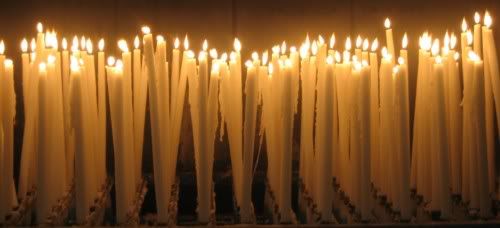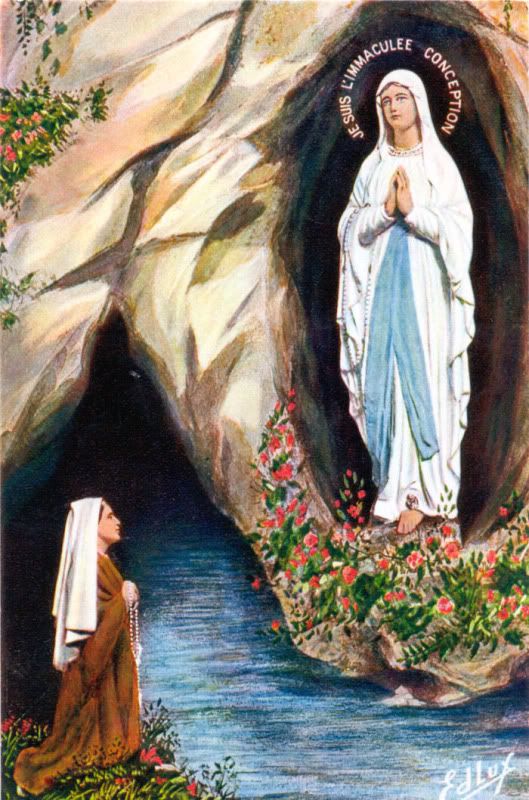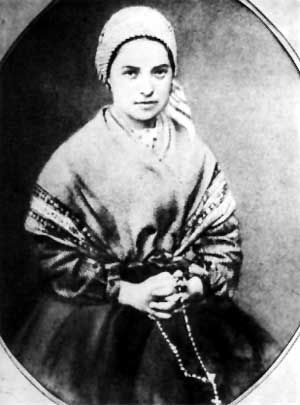As I rededicate myself to this blog, we return to the beginning... the first apparition of Our Blessed Mother to Saint Bernadette Soubirous in the sacred grotto at Lourdes. Let us reflect on the sweet grace of Our Lord, flowing through His Holy Mother, like the fresh springs of water that continue to flow today in Lourdes. Holy Mother of God, bless this undertaking and may the work of this blog be helpful in comforting the suffering, providing hope to those in need, and creating a community of faithful dedicated to your Immaculate Heart. I offer my time and sacrifice as penance for sinners, that they may be freed from the burden of sin and washed clean in the grace of Jesus. Amen.
To understand the message of Lourdes, however, we need to return to the beginning of the story of Bernadette Soubirous, and the sleepy town of Lourdes, sitting at the base of the Pyrénées mountains. Bernadette’s parents, François and Louise Soubirous, had settled in Lourdes, working in the mill owned by Louise’s family. On January 7, 1844, Marie-Bernarde (always referred to as Bernadette) was born, their first child. Over the course of her life, Bernadette’s parents would bring eight additional children into the world, five of which died before reaching the age of ten years old.
Bernadette’s early life was marked by poverty and frequent moves. After her mother suffered an accident, burning herself severely, Bernadette was sent to be wet-nursed by a “foster mother” for approximately 18 months. During that time, her father suffered an accident leaving him blind in one eye, had to sell the mill, could no longer afford to pay the family’s bills, and was eventually evicted from their home. A series of moves to smaller and less comfortable rooms followed, with the family ending up living in a one-room former prison cell, the Cachot, which was rotting and abandoned. During these moves, Bernadette was stuck down with cholera, during on outbreak affecting the area. While she recovered, she was left with permanent ailments of the lungs, including asthma and tuberculosis, as well as general weakness and frailty which remained with her throughout her short life. Following the cholera epidemic, famine struck France, and the government distributed free flour to all, in effect removing any possibility of Bernadette’s father working in the milling business. Instead, he took on chores as a day laborer, as did her mother, but earned too little to adequately support the family.
Due to the family’s financial problems, Bernadette returned to her wet-nurse, now old enough to work. She spent the days in the fields with the sheep, acting as a shepherdess. She neither attended school, nor could she read or write. Living outside of town, she also was unable to participate in formal religious education, and despite being of age, had not made her First Communion. Concerned, her parents brought her back to Lourdes in January 1858, and she began attending Catechism classes to prepare for First Communion with the Sisters of Nevers. Given her lack of education, she was the oldest in her class, with many of her younger classmates better able to read and write. Her instructor deemed her “unteachable,” and the local priest, who would later become her confessor, considered her a “blank slate.”
Despite poverty and hard luck, the Soubirous family was united in love for God and each other. At age 14, Bernadette’s life was about to dramatically change. On Thursday, February 11, 1858, her parents sent her, her 11year-old sister Toinette-Marie, and her 13 year old friend Jeanne Abadien to collect firewood as it was very cold. The Soubirous family could not afford firewood, and the Cachot, where they were living was poorly insulated. The girls left town, and while Toinette-Marie and Jeanne crossed a small stream, Bernadette remained behind. Given the cold temperature, and her penchant for sickness, she was reluctant to wade into the cold water. Instead, she remained behind, searching in what is now referred to as the grotto of Massabielle, but then was little more than a muddy cave strewn with debris that served as a shelter for wild pigs. Having no luck finding usable wood, and seeing her sister and friend moving further away from her, Bernadette sat to remove her stockings, planning on crossing the Savy Canal. As she sat, she heard a sudden gust of wind, but the trees around her remained still. Looking back into the grotto, she saw a beautiful young lady dressed in a white dress with a white veil, and a blue sash. She had yellow roses on each foot, the color perfectly matching the Rosary chain she held on her arm. The beads on the Rosary itself were white. She was surrounded by white light, but it was “not blinding light,” and had beautiful blue eyes. The young woman smiled at Bernadette. “I rubbed my eyes. I thought I was mistaken,” Bernadette would later write in her journal.
Bernadette dropped to her knees, fearful, and pulled the Rosary from her pocket. While she desired to pray, she found herself paralyzed, unable to move her arms. Trembling, she try without success, only able to bless herself with the Sign of the Cross after the smiling woman in white did. She later reported that “immediately after I made the Sign of the Cross, the great fear that had seized me disappeared.” Bernadette prayed the Rosary, with the woman fingering the beads along with her, but remaining silent. As soon as Bernadette had finished the Rosary, the lady beckoned her closer. Bernadette, again afraid, remained kneeling where she was, and the lady disappeared, leaving her alone. Her companions returned, neither having seen anything.
After telling her sister and friend what had happened, she begged them not to mention the apparition to anyone. However, Bernadette’s sister promptly told their mother upon return home, and they were both punished and forbidden to return to the grotto. Bernadette would return, however, drawn to the beautiful young woman, in three day’s time.
Saint Bernadette later wrote in her Journal Dedicated to the Queen of Heaven:
“Dearest Mother, how happy was my soul those heavenly moments when I gazed upon you. How I love to remember those sweet moments spent in your presence, your eyes filled with kindness and mercy for us! Yes, dear Mother, your heart is so full of love for us that you came down to earth to appear to a poor, weak child and convey certain things to her despite her great unworthiness. How humbled she is. You, the Queen of Heaven and Earth, chose to use what is weakest in the eyes of men. O Mary, give the precious virtue of humility to she who dares to call herself your child. O loving Mother, help your child resemble you in everything and in every way. In a word, grant that I may be a child according to your heart and the heart of your dear Son.” (quoted in “A Holy Life: Saint Bernadette of Lourdes,” McEachern, Ph.D., 2005, pages 18-19).
The Blessed Mother appeared to Saint Bernadette eighteen times, bringing a message of prayer, penance, poverty, and participation. She said, “Penance. Penance. Penance. Pray for Sinners.” She picked the most humble of messengers, truly showing that we are all equal in the eyes of the Lord. Between today and July 16, we will journey with Saint Bernadette as we encounter Our Blessed Mother through her eyes, memories, and words.










0 comments:
Post a Comment
Thanks for leaving a comment. If you wish to submit a prayer request, however, please do so above, using the "Contact" tab.